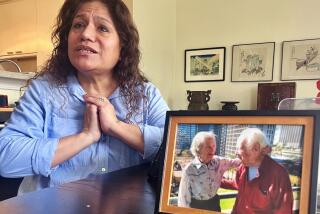Memory Comes Tapping Back for Obit Writer
- Share via
I was working on an asbestos story one day recently when an editor’s message beeped into my computer terminal:
I think we may need an obit on dance teacher etc. Ted Howard. Can you please see if library has anything in files on him?
I checked. The Times library found nothing. Howard appeared in no reference book or dance publication the librarian could find. And The Times had never set this man’s name in type.
I made a hasty check of available dance professionals. They didn’t know the old tap dancer. Nor would Howard’s personal files, untouched since his long illness, assist my attempt to measure the man. Howard’s friend and landlord said the lanky, Canadian-born dancer penciled in only the first names of students. Thus, his friend couldn’t contact them about the funeral, and I couldn’t ask them about Howard.
Realistically, I had to forget about writing anything on him--except for one thing.
I remembered Ted Howard. One of the man’s untraceable students was I.
On a trip to Los Angeles, at least 10 years ago, I took a series of classes with Howard, then nearing 70 years old. The memory of that brief contact rushed back as I listened to his friend, Barbara Perry.
Perry had called The Times about Howard’s death, saying there was more to him than a paid death notice could impart. He deserved to be remembered, she said, echoing the sentiment of anyone who has lost someone they care about.
Perry, with her mother, had owned one of Hollywood’s most important dance studios and rehearsal halls in years past. People like Jimmy Cagney and Agnes DeMille rehearsed or taught there. Ted Howard, she said, had managed Perry’s studios and taught tap there for about 25 years.
“That was his entire life. He taught all day long,” she said, describing someone who elected to train stars, not be one.
“He wouldn’t go on auditions to Broadway shows. He preferred the safety of the rehearsal hall.”
Still, she emphasized, “he was a beautiful, gorgeous dancer.” She recalled when members of the visiting Kirov Ballet, rehearsing at Perry’s, would pause outside Howard’s studio to watch him dance and teach.
Years later, during my lessons, I remembered Howard laughing as he talked of going to movie studios and letting directors film him dancing--from the waist down. The film editors would then intersperse shots of his feet with takes of the lead actor’s face. No moviegoers need ever know. And it wouldn’t be Howard’s light feet that made their imprint in the Chinese Theatre’s cement.
It’s a story Howard would not have remembered himself these last few years. For not long after that lesson series, Alzheimer’s disease began its death crawl over his mind.
Howard stopped teaching. A new generation of students learned elsewhere. And even his many friends either lost track of him or stopped visiting when he evidenced no memory of them. The tangible recollections also disintegrated. The site of Perry’s Studios is now a parking lot at the Hollywood Holiday Inn.
But some remember.
Ralph Hadsell, who owns Capezio’s in Hollywood, recalls Howard’s special-order tap shoes. The finest black character oxfords with maple heels and Morgan taps.
Actress Meg Wilson remembers that Howard played the vaudeville circuit in New York, Chicago and Las Vegas with a partner named Larry before settling on teaching. “Ted and Larry had one of the most spectacular acts,” she said, “lots of taps, flips, splits and slides, extremely high kicks. His style was ballet-style actually, with close floor taps.”
As an instructor, Wilson said, “I can’t believe what a generous, giving person he was. He’d help you with a step. He’d give you a routine. You never could quite pay him back. He didn’t want anything.”
A man who lived and worked near the Hollywood Boulevard Walk of Fame, Howard never stepped across his own name.
There would be no star for Ted Howard. And no headlines. But I remembered him. Picking up the paper, I turned to the death notices--to read the names I didn’t recognize.
More to Read
The biggest entertainment stories
Get our big stories about Hollywood, film, television, music, arts, culture and more right in your inbox as soon as they publish.
You may occasionally receive promotional content from the Los Angeles Times.











